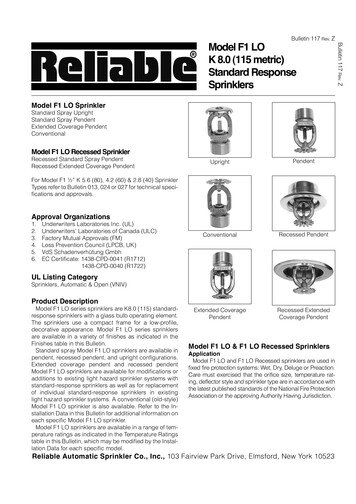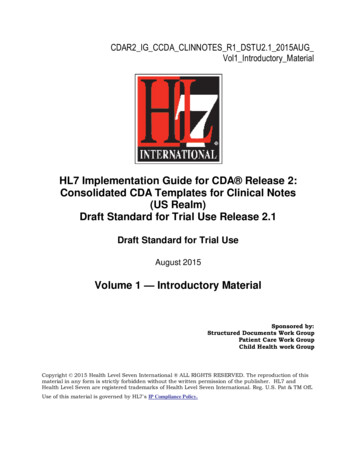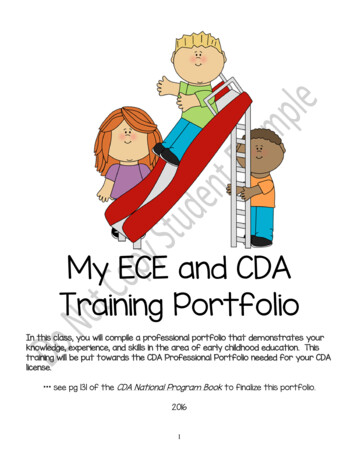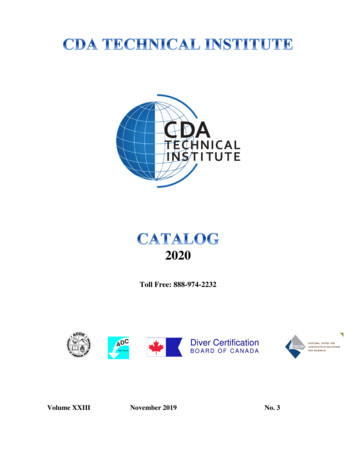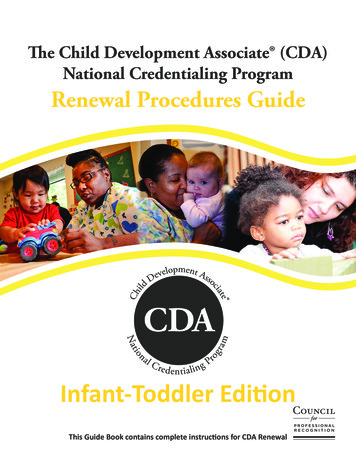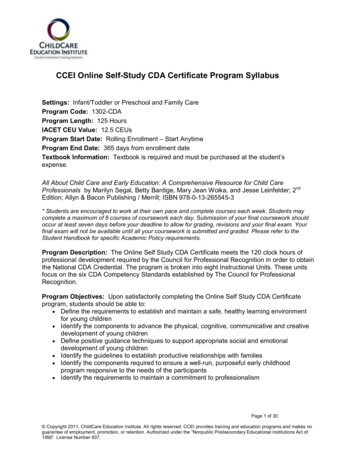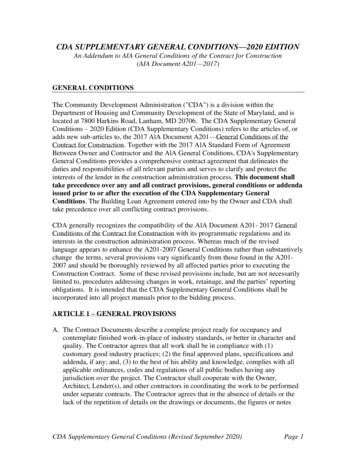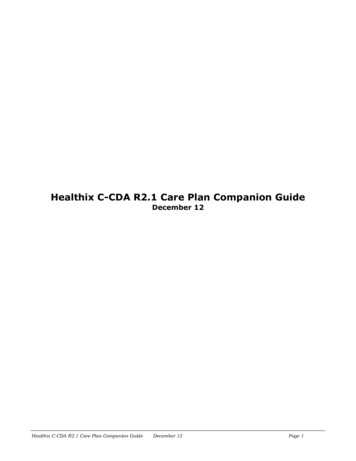
Transcription
Concise Consolidated CDA:Deploying Encounter Summary CDADocuments with Clinical NotesJune 2018
Executive SummaryIn the Fall of 2017, the independent Carequality and CommonWell Content Work Groups wereattempting to solve a set of common issues: unacceptably large C-CDA documents, an absence of clinicalnotes in exchanged documents, support for encounter summary documents, and the need fordocument version management. The initiatives agreed to launch a Joint Document Content Work Group(JDCWG) in January 2018 with participants that included clinicians, vendor representatives, andstandards development representatives.This white paper defines a path to improve the content in C-CDA exchange, while acknowledging therealities of present day documentation and exchange practices. The intended audience of this guidanceis C-CDA implementers, product development teams, and software developers.The recommendations resulting from this joint effort include the following: Implementers should support Encounter Summary Documents in addition to Patient SummaryDocuments Encounter Summary Documents should be based upon the C-CDA template for Progress Note(Outpatient/Ambulatory) or Discharge Summary (Inpatient/Hospital) Implementers should incorporate Clinical Notes in C-CDA implementations Content in Encounter Summary Documents should only reflect information at the time of theencounter Implementers should only include a subset of the ONC Common Clinical Data Set by default inan Encounter Summary Document, and only if that data was validated during the encounter Implementers should include a Section Time Range Observation for each section in anEncounter Summary Document Implementers should construct C-CDAs that reflect the scope of document query parametersThe next steps related to these recommendations are for Carequality and CommonWell representativesto present them to their respective Steering Divisions to determine how to encourage implementation.Additionally, these recommendations will be shared with HL7 for possible inclusion in a future version ofC-CDA.
Table of Contents1 Introduction1.1 Purpose1.2 Audience1.3 Background and Development Approach1.3.1 Sources and Process444452 Encounter Summary Documents2.1 Document Body Guidance2.1.1 Section Time Range2.2 Outpatient/Ambulatory Summary (Progress Note Document)2.3 Inpatient/Hospital Summary (Discharge Summary Document)2.4 Clinical Notes2.4.1 Common Clinical Note Types2.4.2 Sending Clinical Notes in C-CDA2.4.2.1 Note directly attached to the associated act2.4.2.2 Note is in an appropriate section2.4.2.3 Note in stand-alone Notes Section2.4.3 Encounter Linking for Clinical Notes2.4.3.1 Clinical Note Best Practices789101112131313151516173 Patient Summary Documents3.1 Honor time parameters in Query for Documents3.2 Missing Time parameters3.3 USCDI within TEFCA191920234 Smart Senders and Resilient Receivers4.1 Smart Senders4.1.1 Maintain proper references between coded values and narrative4.1.2 Maintain act/observation IDs across documents4.1.3 Document Versioning4.1.3.1 Encounter Summary Document Version Management Guidance4.1.4 Reconciliation flag4.2 Resilient Receivers4.2.1 Document Display Guidance4.2.2 Receive and display any valid CDA document242424242525272828315 Appendix5.1 Additional education material5.2 Document Generation Timing and Content5.3 Future Work32323233
Concise Consolidated CDA:Deploying Encounter Summary CDA Documents with Clinical NotesVersion 1.0June 2018Table of FiguresFigure 1 – Sample display of Section Time Range. 10Figure 2 – Progress Note Document Section Requirements . 11Figure 3 – Discharge Summary Document Section Requirements . 12Figure 4 – Example of Note Attached to an Act. 14Figure 5 – Example of Note Added to an Appropriate Section . 15Figure 6 – Example of Stand-alone Notes Section . 16Figure 7 – Example of Encounter Linking with entryReference . 17Figure 8 – Example of Encounter Linking with entryReference . 17Figure 9 – Timespan Elements in the Query Transaction . 20Figure 10 – VA Section Timespan Filters . 22Figure 11 – ONC Draft USCDI . 23Figure 12 – Example id root only . 25Figure 13 – Example id root extension. 25Figure 14 – Discharge Summary with no Hospital Course information . 26Figure 15 – Replacement Discharge Summary document with Hospital Course Information . 27Figure 16 – Document Query . 28Figure 17 – Document Retrieval . 29Figure 18 - Document Information Available during the IHE Query and in the stored C-CDA . 30Figure 19 - Sample Document List Display . 30Page 1
Concise Consolidated CDA:Deploying Encounter Summary CDA Documents with Clinical NotesVersion 1.0June 2018AcknowledgementsThis guide was developed through a joint effort of Carequality and CommonWell.Primary EditorBrett MarquardEd DonaldsonOrganizationDoD / VA Interagency Program Office (IPO) / WaveOneOneRecord / Ready ComputingThe editors appreciate the collaborative efforts and commitment from all participants to improve thequality of C-CDA documents. Work Group participants included:ContributorAlan SwensonAnand PrabhuAva SpetalnickBecky ShoemakerBenjamin FlessnerChristopher DickersonChristopher J. HillsCorey ParkerDana GroveDave CasselDavid Camitta MD, MSDavid Parker MDDidi DavisElizabeth R. AmesEric HeflinFarah SaeedHolly Miller MD, MBAJason GoldwaterJitin AsnaaniJoe WallJustin WareKelly BundyLeanna EvansLisa R. NelsonLizz RestatLuke DolesMadhav DarjiMargaret Donahue, MDMarie SwallMarty PrahlOrganizationKno2MediportalAthenahealthDignity HealthRedoxCarequalityDoD / VA Interagency Program Office (IPO)Greenway HealthCernerCarequalityDignity HealthDoD / VA Interagency Program Office (IPO) / Defined ITeHealth ExchangeSutter HealthThe Sequoia ProjecteClinicalWorksMedAlliesCedar Bridge GroupCommonWell Health althNY eHealth CollaborativeeClinicalWorksUS Department of Veterans AffairsUS Department of Veterans Affairs / JP SystemsSocial Security AdministrationPage 2
Concise Consolidated CDA:Deploying Encounter Summary CDA Documents with Clinical NotesMike WarnerMoti MitteldorfNick KnowltonRene Cabral-DanielsRobert “Bo” Fried, MDRuss OttSandi MitchellSteven Lane, MD MPHTherasa BellVirginia YostVersion 1.0June 2018CernerWombaBrightreeCommunity Care Network of VirginiaEagle PhysiciansDoD / VA Interagency Program Office (IPO) / DeloitteUS Department of Veterans Affairs / JP SystemsSutter HealthKno2US Department of Veterans Affairs / JP SystemsPage 3
Concise Consolidated CDA:Deploying Encounter Summary CDA Documents with Clinical NotesVersion 1.0June 20181 IntroductionCarequality and the CommonWell Health Alliance are two industry initiatives committed to the seamlessexchange of healthcare information. This guide is the result of a joint development effort of the ContentWorkgroups within each initiative to improve the content of Consolidated CDA exchange.1.1 PurposeThis document provides guidance for including Clinical Notes, and guidance for exchanging EncounterSummary CDA Documents. A Clinical Note is narrative text a clinician wrote, dictated, or copied fromother portions of the patient’s chart. An Encounter Summary CDA document will include this ClinicalNote (required) plus other relevant sections with discrete data as generated by the system and/orincluded per clinician instructions.This document complements the Health Level Seven (HL7) CDA R2 IG: C-CDA Templates for ClinicalNotes STU Release 2.1. It is also not a replacement for the C-CDA Templates for Clinical Notes R1Companion Guide, which primarily supports the requirements of the ONC 2015 Edition CertificationCriteria (2015 Edition) Certified Electronic Health Record Technology requirements. The guidanceprovided here will be considered in a future update to C-CDA.1.2 AudienceThe primary audience of this guide is C-CDA implementers, product development teams, and softwaredevelopers. This guide provides detailed guidance for placement of clinical information in C-CDA andbest practices for system generators and receivers. Software architects, business analysts, and policymanagers can also benefit from understanding the preferred approach of supporting EncounterSummary documents in addition to Patient Summary documents.1.3 Background and Development ApproachIn the fall of 2017, independent Carequality and CommonWell Content Work Groups were attempting tosolve a set of common issues: unacceptably large C-CDA documents, an absence of clinical notes inexchanged documents, support for encounter summary documents, and the need for document versionmanagement. Participants from both content work groups approached the Directors of Carequality andCommonWell to consider a single joint effort to tackle these common issues. The Joint Work Grouplaunched in January 2018. Participants in the Joint Content Work Group included clinicians, vendorrepresentatives and participants involved in standards development.The principles of the Joint Content Work Group were as follows:1. Maintain an initiative agnostic perspective2. The product of the work group should be a best practices document1. Exact format to be determined2. Carequality and CommonWell may reference document or incorporate into theirmaterialPage 4
Concise Consolidated CDA:Deploying Encounter Summary CDA Documents with Clinical NotesVersion 1.0June 20183. All final material will have joint branding or none3. Development will occur in single content work group4. Initiatives will independently review and approve guidance5. Any guidance developed may be transitioned over to HL7 for balloting and maintenanceThe Joint Work Group set clinical and technical priorities in the first call as follows:Clinical1. Require Encounter specific document support1. Outpatient/Ambulatory Summary (Progress Note Document) with defined sections2. Inpatient/Hospital Summary (Discharge Summary Document) with defined sections2. Determine most frequently used Clinical Note types1 - develop examples for each to include inencounter specific documents3. Develop guidance on Note placement within documents for generator and consumer4. Require Patient Summary1. Define patient-level (not encounter specific) sections to always include2. Future – Define default time ranges for each sectionTechnical1. Develop guidance for document versioningPrior to the launch of the Joint Content Work Group each individual content work group discussedtackling the size of exchanged CCDs by discussing appropriate content restriction by section. It becameclear, that even improved filtering of a single patient CCD wouldn’t solve the information overload forclinicians reviewing documents that could sometimes be over 1,000 pages in length.The group focused on the importance of providing focused information to the clinician at the time theyneed it. The group identified encounter specific document support, including clinical notes, as the toppriority. Members felt that the information provided by clinical notes would provide criticalsupplemental context to the discrete data they were currently getting in Patient Summary CCDdocuments. They also felt that these notes should not be added to the already long Patient SummaryCCD documents they were receiving.After the Joint Content Work Group finalized priorities, weekly calls were scheduled to develop andreview design approaches. Decisions were made through discussion and consensus without theimplementation of formal voting.1.3.1 Sources and ProcessThe Joint Content Work Group considered the C-CDA R2.1, and Companion Guide as the baseline for alldiscussions. As a guiding principle, the Joint Content Work Group focused on providing complementary,1With support from our Argonaut colleagues!Page 5
Concise Consolidated CDA:Deploying Encounter Summary CDA Documents with Clinical NotesVersion 1.0June 2018not conflicting guidance. Starting in January 2018, the Joint Content Work Group met weekly to developsolutions to the identified priorities. The presentations from each week reside in a shared google drive.Other standard or guides referenced through the development: Health Level Seven (HL7) CDA R2 IG: C-CDA Templates for Clinical Notes STU Release 2.1 HL7 CDA R2 IG: C-CDA Templates for Clinical Notes R1 Companion Guide, Release 1 Draft ONC U.S. Core Data for Interoperability (USCDI)Page 6
Concise Consolidated CDA:Deploying Encounter Summary CDA Documents with Clinical NotesVersion 1.0June 20182 Encounter Summary DocumentsAn encounter summary document is primarily a clinician authored collection of information specific to asingle patient interaction with a clinician, care team or hospitalization. The document may be providedto a patient immediately upon, or soon after, the conclusion of their visit even if all the informationrelated to that visit is not yet available. For example, an encounter may have pending laboratory resultsor may lack a finalized clinician note or discharge summary when a patient departs. However, anencounter summary document may be updated when additional encounter specific data is available (i.e.finalized). A complete encounter summary includes any information that may have been updated afterthe conclusion of the encounter. See Document Versioning section for guidance on how to managedocuments versions and updates.For the purposes of document exchange, this guide focuses on two Encounter Summary Documenttypes: Outpatient/Ambulatory Encounter Summary Inpatient/Hospital Encounter SummaryIt is important to note these two broad categories may not perfectly align with patient billing classes.This guide does not define exact scenarios of when to use each type of encounter summary. The groupconsensus was to use the outpatient/ambulatory encounter summary for office visits, and use theinpatient/hospital encounter summary for overnight stays in hospitals. For hospital outpatient services(ambulatory surgery, etc.) or inpatient rehabilitation the provider/organization may need to determinewhich encounter summary document type is most appropriate.This supplement provides guidance for generating the C-CDA Progress Note Document to exchangeinformation associated with an Outpatient/Ambulatory Encounter, and the C-CDA Discharge SummaryDocument to exchange information associated with an Inpatient/Hospital Encounter. The Joint ContentWork Group selected these information exchange documents because they were designed to supportthe most generic, encounter level documents currently available. After systems support the ProgressNote Document, and the Discharge Summary Document, implementers are encouraged to implementadditional document types that support specific use cases, for example Consultation Note Document.Implementation of the Encounter Summary Documents complements the existing Patient Summarydocument exchanged by systems today. Encounter Summary Documents provide information about thepatient used or generated during the encounter. Patient Summary Documents provide the current andhistorical information about a patient. The Joint Content Work Group decided that in order for systemsto provide a complete picture of a patient's history, they SHALL provide access to, at a minimum, oneEncounter Summary Document for each available encounter and a current Patient Summary Document.To help understand this decision, the Joint Content Work Group considered the following scenario:1. A clinician requests a patient’s historical visits from 9/1/2017-12/1/2017.Page 7
Concise Consolidated CDA:Deploying Encounter Summary CDA Documents with Clinical NotesVersion 1.0June 20182. The patient had 3 visits during this time, so the system returns 3 individual Encounter SummaryDocuments.3. Each Encounter Summary Document includes the information (e.g. Medication List) at theconclusion of the encounter.Systems that are unable to report information that is accurate to the time of the encounter SHALL NOTinclude current information instead. If a system provided the current Medication list with eachEncounter Summary, rather than the encounter specific list, all of the documents would have the sameinformation making it impossible for the clinician to determine the state of the patient at the time of theencounter. Thus, systems without the ability to produce a Medication list that accurately reflected theMedications at the end of the encounter, SHALL NOT include a Medication list in the EncounterSummary Document.2.1 Document Body GuidanceThe CDA document body communicates clinical content through sections. C-CDA R2.1 includes robustrecommendations for required and optional sections for the C-CDA Progress Note Document and the CCDA Discharge Document which were determined by the review of thousands of clinical documents. Theadditional guidance here complements this prior work. When HL7 considers a new ballot, members ofthe Joint Content Work Group will submit these recommendations for inclusion.The content work group selected sections for the Progress Note Document and Discharge SummaryDocument using these guidelines:1. Include all sections required in the base C-CDA document template2. Include a priority subset of clinical data drawn from the ONC Common Clinical Data Set(CCDS) and draft US Core Data for Interoperability (USCDI).3. Systems SHOULD send a ‘No information’ assertion template if nothing is available2 for oneof the priority subset data elements.4. Systems MAY send additional data elements, beyond the priority subset, if relevant to theencounter. For these additional data elements, systems should not send a ‘No information’template if nothing is available.Many systems include the data required in the Common Clinical Data Set (CCDS) in every C-CDAdocument even if that data is not updated, or relevant, to an encounter. The participants in the JointContent Work Group recommended that only a priority subset of such data elements always be included(listed below), and only if they were reviewed or reconciled during an encounter. This approach isconsistent with ONC’s requirement that systems must support sending all CCDS for certificationpurposes, but also allows the clinician to determine what is relevant for a particular encounterdocument. The Joint Content Work Group recognizes that reconciliation does not occur the same way in2See HL7 Approved C-CDA Example No InformationPage 8
Concise Consolidated CDA:Deploying Encounter Summary CDA Documents with Clinical NotesVersion 1.0June 2018every system and provides no guidance on this activity. A goal of the Joint Content Work Group is forsystems to only include information which is relevant and current at the time of the encounter.Data elements that require review SHALL NOT be included in the Encounter SummaryDocument if the clinician did not review or reconcile this data at the time of the encounter.Guidance for key sections: Problems - Include those addressed during the encounter as Encounter Diagnoses Allergies - Include only if the system can recreate the active Allergy list at the time of encounter,including those recorded in prior encounters. Medications - Include only if the system can recreate Medications at time of encounter. Immunizations - Include immunizations given during the encounter.Systems SHALL NOT auto-populate the latest information (i.e. current active medications) in ahistorical Encounter Summary Document.3Additionally, every section must comply with the following guidance: Each section must include the Section Time Range Observation to communicate the date andtime range of the information included in the section. See Section Time Range section for moredetail.If the section is required (see Progress Note Document and Discharge Summary Document) itmust include a ‘No information’4 assertion if no information is included for a section.2.1.1 Section Time RangeIn current exchanges, sending systems include varying amount of information in sections. For example,one sender might include immunizations for the current encounter, while another might include allimmunizations on record for the patient. When an end-user reviews a section they may not know whatportion of the available data the sender included. HL7 introduced a new observation, the Section timerange observation5, to communicate what is included in a section. It was balloted with the C-CDACompanion Guide and is available for use in any existing C-CDA section.The purpose statement from the Companion Guide: This observation represents the date and timerange of the information contained in a section. It is an optional entry and may be used in any section.3An exception to this rule is if the last encounter is recent and does contain current information.HL7 example for sending ‘No Information’5C-CDA R2.1 Companion Guide Section Time Range Observation (2.16.840.1.113883.10.20.22.4.201:2016-06-01)4Page 9
Concise Consolidated CDA:Deploying Encounter Summary CDA Documents with Clinical NotesVersion 1.0June 2018The Joint Content Work Group recommends all sections include this observation and correspondingtext. The text should be included underneath the section header and state either: The section includes all information for this encounter Or, the section includes information corresponding to a time range with a low and a high valueFigure 1 – Sample display of Section Time Range2.2 Outpatient/Ambulatory Summary (Progress Note Document)The content work group selected the C-CDA Progress Note document template6 to supportOutpatient/Ambulatory Encounter Summary Document exchange. The Progress Note is a genericdocument which supports any outpatient visit. It is a first step towards systems exchanging morespecific document types per encounter type.The preferred LOINC document type code is 11506-3, Provider-unspecified Progress note, althoughsystems may send more specific codes from the 883.11.20.8.1 value set.Figure 2 – Progress Note Document Section Requirements, below, identifies the sections the JointContent Work Group recommends be required for implementations of the Progress Note documenttype intended to serve as an Outpatient/Ambulatory Summary.6C-CDA R2.1 Progress Note templateId: 2.16.840.1.113883.10.20.22.1.9:2015-08-01Page 10
Concise Consolidated CDA:Deploying Encounter Summary CDA Documents with Clinical NotesVersion 1.0June 2018RequiredRequired if Reviewed7Assessment and Plan Section (V2)Allergies and IntolerancesSection (entries required) (V3)Clinical Notes8 (may include Subjective)Medications Section (entriesrequired) (V2)Encounter Section (V3) with encounterdiagnoses for the specific encounterImmunizations Section (entriesrequired) (V3)Outpatient/AmbulatorySummary (Progress NoteDocument)Figure 2 – Progress Note Document Section RequirementsThe Progress Note Document is not restricted to these sections. Clinicians, or specific sites, may chooseto include other sections relevant to the encounter (Results, Vital Signs, etc.).2.3 Inpatient/Hospital Summary (Discharge Summary Document)The content work group selected the C-CDA Discharge Summary document template9 to supportInpatient/Hospital Encounter Summary Document exchange. The Discharge Summary is a key documentfor patients transitioning from the hospital to a new care setting.The preferred LOINC document type code is 18842-5, Discharge Summary note, although systems maysend more specific codes from the DischargeSummaryDocumentTypeCode value seturn:oid:2.16.840.1.113883.11.20.4.1.Figure 3 – Discharge Summary Document Section Requirements, below, identifies the sections the JointContent Work Group recommends be required for implementations of the Discharge Summarydocument type intended to serve as an Inpatient/Hospital Summary.7Only include if the system is confident a user has reviewed or reconciled the list and is current to the EncounterSummary Document. On generation, systems may include the IHE Reconciliation template to record an explicitreconciliation act.8C-CDA R2.1 Companion Guide Notes Section 2.16.840.1.113883.10.20.22.2.65:2016-11-019C-CDA R2.1 Discharge Summary templateId: 2.16.840.1.113883.10.20.22.1.8:2015-08-01Page 11
Concise Consolidated CDA:Deploying Encounter Summary CDA Documents with Clinical NotesInpatient/HospitalSummary (DischargeSummary Document)Version 1.0June 2018RequiredRequired if ReviewedAllergies and Intolerances Section (entriesrequired) (V3)Problem Section (entries required)(V3)(not covered by DischargeDiagnosis)Hospital Course (C-CDA) Discharge Note10Medications- Admission medications list(patient reported/homemedications)11- Facility Administered12 (Givenduring admission)- Discharge Medications list13Clinical Notes14 (may include Subjective)Immunizations Section (entriesrequired) (V3)Discharge Diagnosis Section (V3)Plan of Treatment Section (V2)Figure 3 – Discharge Summary Document Section RequirementsThe Discharge Summary Document is not restricted to these sections. Clinicians, or specific sites, MAYchoose to include other sections relevant to the encounter (Results, Vital Signs, etc.).2.4 Clinical NotesClinician authored Clinical Notes capture the health story of a patient – this may include their past andcurrent health as well as planned next steps to improve their health. Clinical Notes are a critical part ofthe patient record. Prior to the formation of the Joint Content Work Group the independent Carequalityand CommonWell content work groups were discussing methods to exchange Clinical Notes in C-CDA.Additionally, in response to requirements within the 21st Century Cures Act to identify a common set ofdata for exchange, the Office of the National Coordinator (ONC) proposed the U.S. Core Data forInteroperability (USCDI) include Clinical Notes. The exchange of Clinical Notes is also a high priority forthe further development of the Fast Healthcare Interoperability Resources (FHIR) specification assupported through the Argonaut Project. Fortunately, for all activities HL7 drafted an initial approach for10If discharge note summarizes what occurred in the hospital - include Note Activity, label text as ‘Discharge Note’.Admission Medications Section (entries optional) (V3) cations Administered Section (V2) harge Medication (V3) A R2.1 Companion Guide Notes Section 2.16.840.1.113883.10.20.22.2.65:2016-11-0111Page 12
Concise Consolidated CDA:Deploying Encounter Summary CDA Documents with Clinical NotesVersion 1.0June 2018exchanging in the HL7 C-CDA companion guide15 using the new Notes Section16 and Notes Activity17. TheHL7 guidance provided a baseline for the additional guidance here.2.4.1 Common Clinical Note TypesThe LOINC terminology includes thousands of different note types. To focus the industry, the Argonautparticipants and the Department of Veterans Affairs contributed their most commonly used note typesto develop the following list of top notes: Discharge documentation (8648-8 and/or 18842-5) Consultation (11488-4) Imaging narrative (18726-0) Lab/path narrative History & Physical (34117-2) Progress note Procedures note (28570-0)The list is not in a priority order, nor does it represent the exclusive list of what systems can and willsupport. All systems are encouraged to support this list and additional notes from the Note Types valueset. Any future standards publications should not be restricted to this list.2.4.2 Sending Clinical Notes in C-CDAThe introduction of the Notes Section and Notes Activity entry templates in the HL7 C-CDA companionguide provided structure and guidance for sending notes. Depending on the clinician workflow, and thediscrete information available at time of document creation, the participants agreed on three potentialapproaches in priority order:1. Include Note(s) directly attached to the associated act2. Include Note(s) in an appropriate standard section3. Include Note(s) in a stand-alone notes section2.4.2.1 Note directly attached to the associated actWhen a note is specifically about an action a clinician performed, the note should reference that action.For example, a Procedure Note is linked, or nested within, the procedure it documents. When directattribution is possible (as an entryRelationship), the clinical note should be included in the appropriatesection where the act is included. Receiving systems should be prepared for Clinical Notes directlyembedded in an act and pr
Farah Saeed eClinicalWorks Holly Miller MD, MBA MedAllies . plus other relevant sections with discrete data as generated by the system and/or included per clinician instructions. This document complements the Health Level Seven (HL7) CDA R2 IG: C-CDA Templates for Clinical . which primarily supports the requirements of the ONC 2015 .
